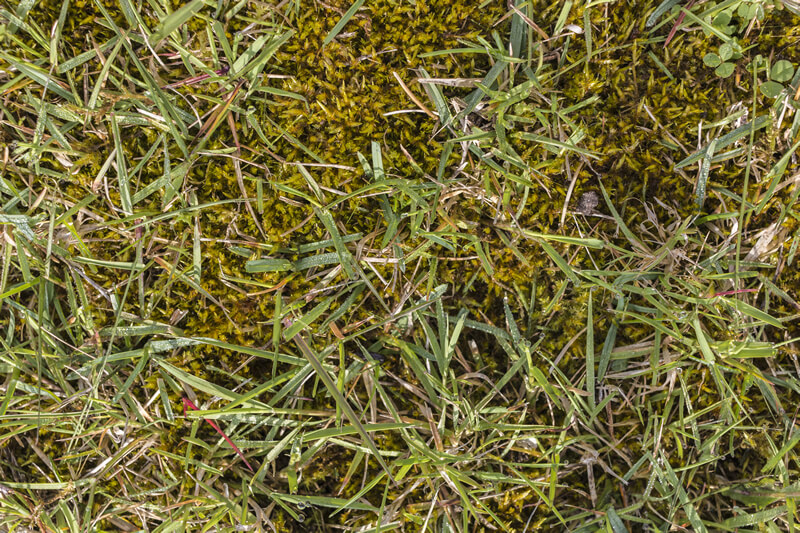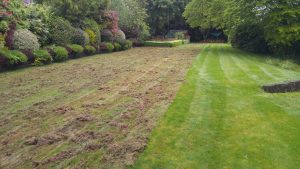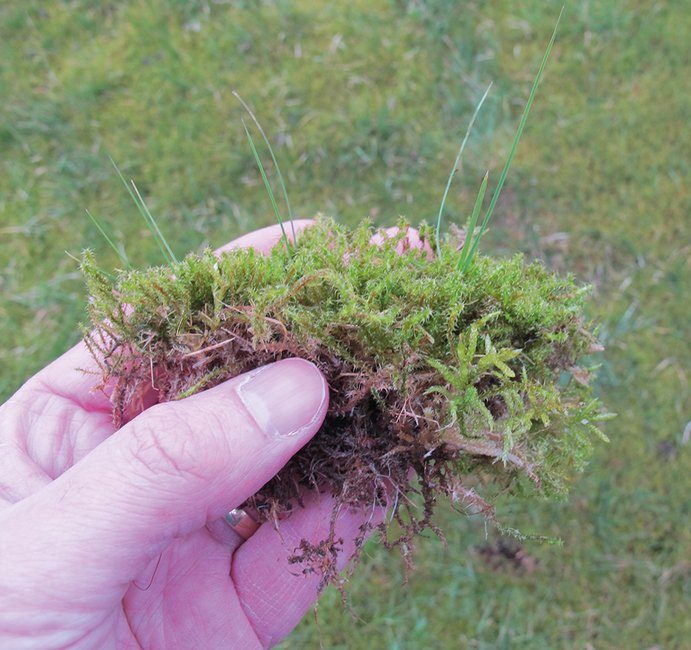Why remove moss from my lawn?
- Leaving moss un-checked can make it harder to mow your lawn as the mower becomes clogged or sinks into the deep moss
- Excessive moss levels can prevent essential moisture, nutrition, and oxygen from entering the soil
- Mossy lawns suffer more from diseases such as red-thread and fusarium patch
- Moss dries out quickly in the summer leaving a bare lawn with unsightly brown patches
- Moss is relatively simple to control. If your lawn has developed moss issues get them under control before they become a major issue
What causes lawn moss?
How can I deal with moss in my lawn?
How can I prevent lawn moss?
If so, read on…
Lawn moss briefly explained…
- Moss is more likely in lawns that are not receiving the correct nutrition
- Shaded lawn conditions encourages moss is your lawn
- Moss is easily spread around your lawn by mowing too short
- Moss likes damp conditions – address drainage issues
- Treated moss – Untreated moss

What is lawn moss and where does it come from?
There are many types of moss found it lawns. Moss anchors in place with small hair-like structures and doesn’t have a root system like most other plants. Moss spore will settle on bare areas of soil and soon begin to colonise that area, spreading quickly in the right conditions. Moss can also be spread by cuttings. It’s essential that you never mow short enough to spread moss around your garden
When is moss not a problem?
Moss is soft and spongy; it feels nice under-foot and is comfortable to walk or sit on. However, it really has no place in a garden lawn as it can cause major issues. Read on…
Why is lawn moss a problem?
Moss can quickly establish itself in a lawn if the conditions are right. It spreads rapidly and can quickly outcompete grass, starving it of light, moisture, and nutrition. As your lawn grasses die back the lawn soon becomes predominantly moss which can make mowing difficult. Moss has a high water content. In dry weather it soon turns brown, resulting in an unattractive lawn with bare areas, ideal for weed seed germination.
Lawn moss, pests, and diseases
Lawn moss likes to retain moisture. Many lawn diseases such as fusarium patch, anthracnose, red-thread, and snow mould also like damp grass conditions. To avoid excess risk of lawn diseases it’s important that the lawn is well drained, and moss certainly doesn’t help with this. It is also thought that pests such as leatherjackets and chafer grubs prefer a mossy lawn.
Moss, nutrition, and drought problems
Lawn moss acts like a sponge, soaking up and holding onto as much water as possible. This can prevent water from reaching the soil below and the root-zone of your lawn. Moss is more of a problem in lawns that don’t have the correct lawn fertiliser plan in place. Poorly fed grass is less able to compete with moss. A thick layer of moss in your lawn is likely to make it harder for any applied fertiliser to reach your grass plants. Weaker lawn grass is more likely to suffer from disease, die-back and weed infestation.
Is lawn moss and thatch the same thing?
No, moss is a living plant and thatch is a layer of dead organic matter usually made up of leaves
How to reduce moss in a lawn
- Deal with shade issues by cutting back overhanging shrubs and raising the canopy of garden trees
- Ensure your lawn is receiving the correct fertiliser programme to maintain healthy grass
- Never mow short into the moss layer in your lawn – this will spread it around more
- Scarify your lawn regularly to ‘power-rake’ out any moss before it becomes a problem
- Treat for moss with a liquid moss-inhibitor. We also add a wetting agent to aid penetration into the plant
- Deal with compaction and drainage issues through annual aeration
- Improve soil structure by top-dressing your lawn
How to remove moss from a lawn
- Scarify or rake the lawn to remove as much moss as possible
- Aerate the lawn to improve soil drainage
- Treat the area with a liquid moss killer after you have scarified
- Ensure the grass is receiving the correct nutrition to aid recovery
- Over-seed the lawn regularly to fill in any areas of bare soil
What time of year is it best to scarify a lawn?
Scarification can be an intensive process, especially if a lawn has become very mossy or allowed to deteriorate significantly. If this is the case then the best time to scarify your lawn will be early spring or autumn when grass is growing and the lawn will find it easier to recover from the scarification process. For lawns that are scarified more frequently the window to scarify your lawn can be extended. Make sure conditions are right for scarifying. You don’t want to be carrying out this process in a period of extreme heat or drought.
How many times a year should you scarify a lawn?
Lawns are unlikely to need scarifying more than once in any year. Many lawns can be scarified less frequently than this, depending on the grass types present in the turf.
How much does lawn scarification cost?
This will depend on a couple of different factors. The first and most obvious is the size of your lawn. The bigger the lawn the bigger the invoice. Lawns that have regularly been scarified are likely to be less work thank those that have not and this will also be reflected in the cost.
How do I know if my lawn needs scarifying?
A lawncare professional will be able to guide you as to whether this process is required. However most lawns will benefit from annual scarification in the right season, to open up the surface, reduce dead organic matter and remove moss.
Will grass grow back after removing moss?
If grass is present it will recover quickly following scarification. However if there is more moss than grass then your lawn may well need some additional seeds added.

Remove moss by scarifying

 Established 2016
Established 2016




